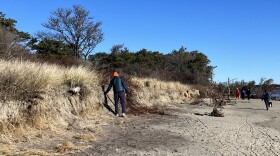In waters just off Clinton, Connecticut, Samuel Tucker and his first mate, his 10-year-old daughter, Susannah, haul cages from the bottom of Clinton Harbor onto their boat, the Alley Oop.
Inside those cages sit bags of hundreds of the Tuckers’ oysters, which they’ve grown here for more than a year. Today, they’re washing the bivalves to clear them of mud and detritus.
“The more mud, the more gross stuff, the less that the oysters can filter and can breathe, can eat,” the older Tucker explains.
He takes a bag and dips it into the harbor from over the side of the boat, then shakes.
“You can see all the shell falling in the water there,” he says, describing the unwanted “growth edge” shearing off with each shake.
These ways of the trade weren’t handed down to Tucker via a family history of oystering. For more than two decades, he’s been a school music teacher, not an oysterman. But a few years ago, a friend gave him a book about the oyster industry and he became fascinated. Then, he discovered a Connecticut program perfect for dipping his toes in the waters of aquaculture.

Shellfishing 101
In a seminar room overlooking Long Island Sound, Mike Gilman lectures on shellfish hatcheries to a dozen students at the University of Connecticut’s Avery Point campus in Groton.
Gilman co-teaches Foundations of Shellfish Farming, an annual, 12-week course put on by Connecticut Sea Grant and UConn Extension.
“We dub it as a training course for those interested in getting into the commercial shellfish industry in Connecticut,” Gilman says.
Students – some established shellfish farmers, others interested in seeing if the industry is right for them – learn everything from shellfish biology to boat maintenance, from best business practices to the bureaucratic ins and outs of permitting and regulations.
“We do a lot of talking about hurdles and what are going to be some of the difficulties, and we sprinkle in the good stuff along the way,” Gilman says. “Growing and farming an animal, being able to enjoy that product at the end, being able to share that with communities, being able to sell it.”

Connecticut’s shellfish ‘pipeline’
The course has the support of the state of Connecticut, too. The Department of Agriculture provides funding for scholarships for some students to enroll for free. Agriculture Commissioner Bryan Hurlburt says shellfish farming is an important part of Connecticut’s culture and history – as well as its economy.
“We ship oysters from Long Island Sound to New York City to Boston, down to D.C., as far away as Minnesota and Texas. So there’s a market for Connecticut oysters,” Hurlburt says. “The benefit that the state will receive by having a pipeline of oyster and clam operations ready to go and making sure that they have the skillset to be successful is really important to us.”
Tucker, the oyster farmer in Clinton, looks forward to being part of that pipeline. He expects his oysters to be ready for market by the end of the year.
Sitting aboard the Alley Oop at the dock, he marvels at the evolution of oysters that managed to outlive the dinosaurs.
“They’ve been around for so long. They’ve survived mass extinctions. They’re a magical thing. And they’re so good for you. They’re so good for the environment,” he says.
“I love how they clean the water,” Susannah, his daughter, adds.
“I don’t know that there are that many things in the world that are that much of a net positive,” Tucker says.









